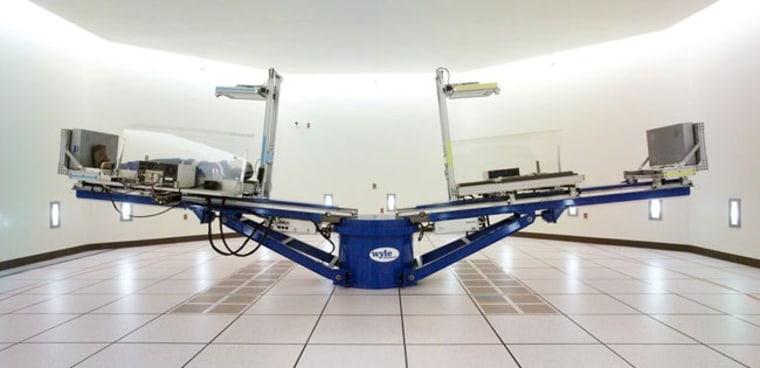New plans for artificial gravity tests in space using centrifuges may hold the key to helping future astronauts ward off the debilitating loss of muscle and bone due to weightlessness on long missions to asteroids or the moon under NASA's revised space exploration plan.
The new NASA budget proposed by President Barack Obama not only sets sights on long-duration missions, but also extends the lifetime of the International Space Station.
Upgrades for the space station "could include a centrifuge to support research into human physiology," according to a summary by the Office of Management and Budget.
Space station residents currently rely upon different exercises to keep themselves fit for the eventual return to Earth. But a spinning centrifuge device could create artificial gravity, which simulates the gravitational tug that a planet such as Earth has. The giant spinning device will give astronauts a healthy break from the weightlessness of space.
"You can try to treat each of the effects of weightlessness system by system, with certain pills for bone loss and certain exercise regimens for the muscles," said Laurence Young, an aeronautics and astronautics engineer at the Massachusetts Institute of Technology. "Or you can treat the root cause of weightlessness by restoring gravity."
NASA's earlier focus on sending astronauts back to the moon meant shorter-duration spaceflight and less urgency to develop artificial gravity. The U.S. space agency focused on traditional countermeasures, such as modifying squats or other exercises to counteract bone and muscle loss, according to Justin Kaderka, an artificial gravity researcher working with Young at MIT.
Now the prospect of longer missions to more distant destinations has once again raised the appeal, if not necessity, of artificial gravity.
Re-creating Earth gravity
One of Young's Japanese colleagues filed a proposal with the Japan Aerospace Exploration Agency months ago to launch a human centrifuge to the International Space Station. The device would ideally take up the diameter of a space station module with a radius as wide as 6.6 feet (2 meters).
Astronauts would lie down on or strap themselves to one end of the centrifuge arm or frame, and experience artificial gravity while the device spins. A rider could also provide the human power to spin the centrifuge by pedaling bicycle-style.
"If you have two arms that'd work nicely," Kaderka told Space.com. "Cycling would give an aerobic workout, and the other person not cycling could do resistance exercises like squats or presses."
The riders on a two-arm centrifuge could then switch off on exercises and on powering the device. A vibration isolator would absorb any residual vibrations that might otherwise disturb the rest of the space station, according to the proposal.
Spin me right round
Earth experiments suggest that artificial gravity works just as well as traditional countermeasures to prevent long-term weightlessness from affecting human cardiovascular health, Kaderka said. He drew that conclusion after reviewing 75 experiments done over the past 40 years for his MIT master's thesis.
But Kaderka also found that more research is needed to assess whether artificial gravity can work its wonders upon muscle and bone. That's partly because researchers must resort to expensive, long-term bed-rest studies to really see the effects on muscle and bone.
One human centrifuge did go into space with the STS-90 "Neurolab" mission aboard the space shuttle Columbia in 1998. But the astronauts spent barely an hour in total testing out the centrifuge during the 16-day mission, which still left the effectiveness of artificial gravity open to question.
"It'd be amazing to get hard data on how artificial gravity is an effective countermeasure in space," Kadera said.
Artificial gravity research has suffered in the latter half of the past decade because of NASA's budget issues and earlier focus on returning astronauts to the moon. No funded centrifuge studies on human physiology currently exist in the United States or among most of its international space partners, Kaderka noted.
Taking the next step
NASA shut down its artificial gravity studies at the Johnson Space Center in Houston several years ago — a decision that resulted in much lost momentum for researchers, according to Young. But both he and Kaderka seemed optimistic that the space agency's new direction would lead to resurgence in artificial gravity work.
Getting a centrifuge up to the space station would do much more than help answer the question of artificial gravity's effectiveness in space, or putting renewed interest in complementary Earth experiments. It would also let researchers start fine-tuning the exact conditions needed for artificial gravity to work.
"One of the hopes is to have the [centrifuge] protocol down to within an hour or so of being spun, because that's roughly how much the astronauts spend doing exercise," Kaderka explained.
Other questions include debate over how fast should the centrifuge spin, setting the ideal artificial gravity level, as well as how much time astronauts will need to spend aboard the centrifuge to see its benefits. Then there are also biomedical questions about whether astronauts encounter problems with dizziness or vertigo, and whether the centrifuge is both effective and enjoyable.
Of course, researchers can begin tackling some of those questions if they can get renewed NASA funding for Earth experiments as well. Otherwise they could be in for a long wait until they see a centrifuge launch to the space station.
"Hopefully we won't have to wait as long as having data come back from a space station centrifuge," Kaderka said.
